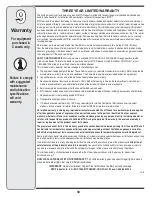
17
4
Operating
Your Lawn
Tractor
WARNING
If you strike a
foreign object,
stop the engine,
disconnect the spark
plug wire(s) and
ground against the
engine. Thoroughly
inspect the machine
for any damage.
Repair the damage
before restarting and
operating.
Driving The Tractor
WARNING: Avoid sudden starts,
excessive speed and sudden
stops.
WARNING: Do not leave the seat
of the tractor without first placing
the PTO (Blade Engage) knob (or
lever) in the disengaged (OFF)
position, depressing the brake
pedal and engaging the parking
brake. If leaving the tractor
unattended, also turn the ignition
key off and remove the key.
1. Depress the brake pedal to release the parking brake
and let the pedal up.
2. Move the throttle lever into the FAST (rabbit) position.
IMPORTANT: Do NOT use the drive pedal to change the
direction of travel when the tractor is in motion. Always
bring the tractor to a complete stop before pivoting the
drive pedal from forward to reverse or vice versa.
3. To travel FORWARD, slowly depress the upper por-
tion of the drive pedal forward until the desired speed
is achieved. See Figure 4-6.
4. To travel in REVERSE, check that the area behind
is clear then slowly depress the lower portion of the
drive pedal with the ball of your foot (NOT your heel)
until the desired speed is achieved. See Figure 4-6.
Driving On Slopes
Refer to the SLOPE GAUGE on page 3 to help determine
slopes where you may operate the tractor safely.
WARNING: Do not mow on
inclines with a slope in excess
of 15 degrees (a rise of approxi-
mately 2-1/2 feet every 10 feet).
The tractor could overturn and
cause serious injury.
• Mow up and down slopes, NEVER across.
• Exercise extreme caution when changing direction on
slopes.
• Watch for holes, ruts, bumps, rocks, or other hidden
objects. Uneven terrain could overturn the machine.
Tall grass can hide obstacles.
• Avoid turns when driving on a slope. If a turn must be
made, turn down the slope. Turning up a slope greatly
increases the chance of a roll over.
• Avoid stopping when driving up a slope. If it is
necessary to stop while driving up a slope, start up
smoothly and carefully to reduce the possibility of
flipping the tractor over backward.
Moving the Tractor Manually
Your tractor’s transmission is equipped with a hydrostatic
relief valve for occasions when it is necessary to move
the tractor manually. Activating this valve forces the fluid
in the transmission to bypass its normal route, allowing
the rear tires to “freewheel.” To engage the hydrostatic
relief valve, proceed as follows:
• Locate the hydrostatic bypass rod in the rear of the
tractor. See Figure 4-7.
• Pull the hydrostatic bypass rod outward, then down, to
lock it in place.
NOTE: The transmission will NOT engage when the
hydrostatic bypass rod is pulled out. Return the rod to its
normal position prior to operating the tractor.
IMPORTANT: Never attempt to move the tractor manu-
ally without first engaging the hydrostatic relief valve.
Doing so will result in serious damage to the tractor’s
transmission.
Do not leave the seat
of the tractor without
first placing the
PTO (Blade Engage)
knob (or lever) in the
disengaged (OFF)
position, depressing
the brake pedal and
engaging the parking
brake. If leaving the
tractor unattended,
also turn the ignition
key off and remove
the key.
Avoid sudden starts,
excessive speed and
sudden stops.
Figure 4-6
Figure 4-7
Hydrostatic Bypass Rod
















































